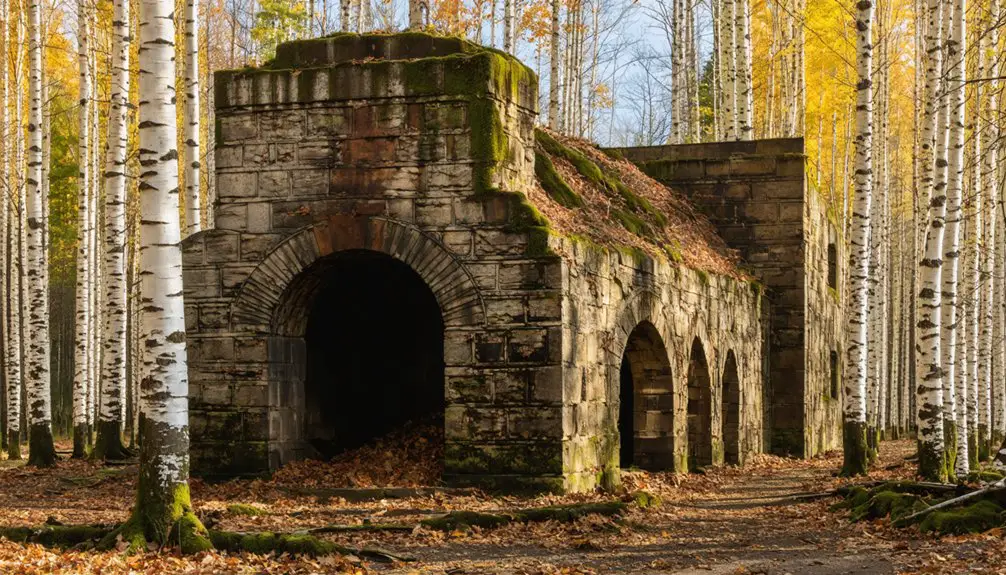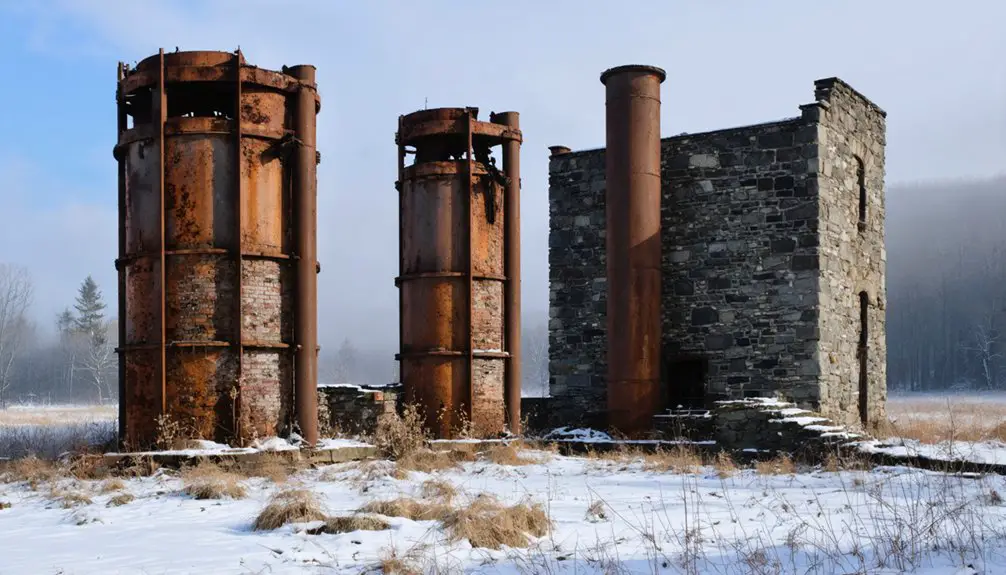You’ll find the remnants of Tyson Furnace, established in 1835 by Isaac Tyson, along Vermont’s Black River Valley near Plymouth. After discovering rich iron ore deposits near Mount Tom, Tyson built blast furnaces that operated until 1855, creating a bustling company town with worker housing, schools, and a general store. Today, stone-lined cellar holes, old mine openings, and industrial ruins peek through the vegetation, while summer homes dot the landscape where this once-thriving mining community stood. The site’s quiet trails hold countless stories of Vermont’s industrial past.
Key Takeaways
- Tyson Furnace was established in 1837 by Isaac Tyson as a company town centered around iron ore mining and smelting operations.
- The site operated successfully for nearly two decades until Tyson’s retirement in 1855, featuring hot-blast furnaces and German-influenced smelting practices.
- Today, stone-lined cellar holes, furnace remnants, and mining equipment ruins mark the abandoned industrial landscape of Tyson Furnace.
- The ghost town area has transformed into a summer homes district, with nature reclaiming much of the industrial ruins.
- Vermont’s Historic Preservation Act protects the site’s archaeological remains, including original foundations and slag deposits from 1880-1902.
The Birth of a Mining Empire (1835)
While prospecting along Vermont’s Black River valley in 1835, Isaac Tyson stumbled upon what would become a transformative iron ore discovery near Mount Tom and Plymouth.
You’d be amazed to know that this wasn’t Tyson’s first mining venture – he’d already made his mark managing copper mines in Strafford, where he ran six smelting furnaces in the early 1830s.
His iron discoveries sparked an immediate “iron excitement” in Plymouth, drawing mining operators from all around who sent their own engineers to verify the deposits.
What made this find particularly special was the presence of superior “steel ore,” perfect for iron production.
Tyson’s expertise in mining innovations, including his patented hot blast smelting process from 1834, positioned him perfectly to capitalize on this new opportunity.
In 1837, Tyson established blast furnaces that became a major center for business and employment in the region.
The furnace operated continuously and successfully until Tyson’s retirement in 1855.
Life in Tyson’s Iron Community
The bustling iron community of Tyson Furnace sprung to life in the 1830s as a quintessential company town, built around the rhythmic pounding of its signature hot-blast furnaces.
The daily community dynamics centered on the foundry, where skilled furnace operators and laborers toiled alongside German-influenced smelting practices.
Seasoned furnacemen and workers labored at the heart of the foundry, their craft shaped by time-tested German smelting traditions.
You’d find worker families settling into company housing, their children attending the local school, while the general store served as a hub for daily necessities.
Transport by stagecoach and river kept the town connected to broader markets.
The workforce adapted to the furnace’s cyclical operations, with multiple generations often working side by side.
Life wasn’t easy – the demanding conditions of charcoal-fueled smelting and mining shaped every aspect of daily existence, but the tight-knit community persevered through economic ups and downs.
The Irish workers formed their own distinct neighborhood known as Dublin, complete with traditional sod houses that stood for many years.
The furnace was renowned for producing the unique Tyson stoves, which became a signature product of the ironworks.
The Rise and Fall of Mining Operations
Mining operations in Tyson Furnace kicked off in 1835 when Isaac Tyson discovered rich iron ore deposits in Plymouth, Vermont. Before this, he’d already been exploring copper deposits in South Strafford since 1828, where he’d constructed six innovative furnaces by 1834.
You’ll find Tyson’s legacy in his pioneering hot blast smelting techniques – he even secured a patent in 1834. Despite these technological advancements, the copper operations couldn’t weather the harsh economic fluctuations of the 1830s, shutting down by 1837.
The iron operations fared better, running successfully for two decades until 1855.
The Tyson family tried reviving the South Strafford mines from 1880 to 1902, introducing steam-powered hoists and improved ore sorting. But they couldn’t overcome the persistent challenges of complex ore processing and fierce market competition.
What Remains: A Ghost Town’s Footprint
You’ll find stone-lined cellar holes and faint footpaths scattered across Tyson Furnace’s landscape, offering silent testimony to the once-bustling mining town’s existence.
The remnants of mining infrastructure, while mostly obliterated, can still be traced through subtle terrain features that mark former furnace sites, machine shops, and boarding houses. The area’s transformation into a summer homes district reflects its modern identity.
Isaac Tyson’s discovery of iron ore deposits in 1835 sparked the town’s establishment and brief prosperity. Nature has steadily reclaimed the town’s footprint, with vegetation covering much of the industrial ruins, though you can still spot mine openings and dumps from the 1880s era along Sargent Brook.
Cellar Holes Still Stand
Scattered across Vermont’s Black River Valley, stone-lined cellar holes mark the vanished footprint of Tyson Furnace, a once-bustling iron mining town founded in 1835.
Through cellar exploration, you’ll discover these stone-lined depressions that once supported homes, stores, and boarding houses until mining operations ceased in the mid-19th century. Near Echo Lake Inn, established in 1840, the ruins offer a glimpse into the area’s rich history.
The historical significance of these remnants can’t be understated – they’re your window into Vermont’s mining heritage.
- Each depression tells a story of families who worked the mines, built their lives, and eventually moved on.
- Stone-lined walls have weathered decades, preserving the exact boundaries of 19th-century foundations.
- Hidden beneath forest growth, these cellar holes stand as silent witnesses to the town’s boom-and-bust cycle.
Mining Remnants Tell Stories
Beyond the cellar holes lie the extensive industrial remains of Tyson Furnace‘s once-thriving copper operation.
You’ll find the remnants of innovative mining techniques across ten acres, including a massive 48-inch water-jacket furnace that produced 40 tons of copper matte daily during 1882-1884. The site reveals how miners extracted ore through adits and shafts, while engineers diverted Copperas Brook through concrete pipes to manage tailings.
The industrial footprint tells stories of community dynamics too – up to 170 workers, from molders to blacksmiths, once called this place home. Like other Vermont copper operations, the workforce consisted primarily of Cornish and Irish immigrants.
Their daily lives are preserved in company account books and archaeological deposits beneath the workers’ housing foundations. Though most structures are gone, the 32 acres of tailing piles and abandoned mine openings stand as silent witnesses to this once-bustling enterprise.
Nature Reclaims Mining Town
While nature has steadily reclaimed the abandoned Tyson Furnace site, subtle traces of its mining past still mark the landscape.
You’ll find native hardwoods and pines dominating the canopy where industrial buildings once stood, showcasing nature’s resilience through ecological restoration. The site’s wildlife resurgence is evident as animals return to their former habitat, now punctuated by depressions and spoil heaps from mining operations.
- Stone-lined cellar holes peek through dense underbrush, whispering stories of the workers who once called this place home.
- Small ponds in old mining pits create unexpected sanctuaries for local wildlife.
- Seasonal changes paint a striking contrast between ghost town clearings and the surrounding mature forest.
The land’s gradual healing mirrors Vermont’s evolution from industrial heritage to natural sanctuary.
Natural Treasures of the Black River Valley
The Black River Valley stands as one of Vermont’s most ecologically diverse regions, where class-II rapids and tranquil waters create a mosaic of aquatic habitats.
Vermont’s treasured Black River winds through varied landscapes, its waters shifting between gentle pools and rushing rapids, nurturing life at every turn.
River ecosystems thrive here, supporting rare Vermont wildlife through essential corridors that connect the northern countryside. Paddlers can explore the waterways through covered bridges and past stunning waterfalls. You’ll find geological features dating back 345-395 million years, including Black Mountain’s exposed granite ridgetops and remnants of ancient Lake Hitchcock’s floodplain terraces. The summit’s natural beauty attracts numerous turkey vultures and ravens.
The landscape’s a living museum where you can paddle half-day trips from Irasburg to Coventry, spotting wildlife along banks stabilized by diverse vegetation.
Mixed hardwood and conifer forests blanket the valley, while specialized plant communities cling to dry ridgetops. When you’re exploring the mountain trails, you’ll get stellar views of Mount Monadnock across terrain shaped by glacial forces.
Preserving Vermont’s Mining Heritage

You’ll find fascinating remnants of Vermont’s mining heritage at Tyson Furnace, where archaeological teams work to protect the site’s 19th-century blast furnace and original foundations from 1880-1902.
The preservation efforts document surviving mining equipment, including ore carts, water-powered machinery components, and extensive slag deposits that tell the story of copper production.
Archaeological Site Protection
Protecting Vermont’s historic mining sites involves a complex web of federal and state regulations, with the Vermont Historic Preservation Act serving as the primary framework under 22 V.S.A. §§ 742(a)(1) and (5).
You’ll find archaeological significance emphasized through multi-agency coordination between the EPA, Vermont DEC, and SHPO. Through site preservation efforts, you’re encouraged to participate in protecting these valuable remnants of Vermont’s industrial past.
- You can review and comment on historic nominations that affect site protections
- You’re able to donate artifacts for educational interpretation
- You’ll see protection measures in place for both planned work and unexpected discoveries
If you’re planning any activities near historic mining sites, you’ll need to navigate permits for waterways and wetlands, especially when exceeding 5,000 SF near Lake Champlain or 1 acre elsewhere.
Mining Equipment Documentation
Documenting historic mining equipment at Tyson Furnace reveals a sophisticated operation that processed up to 600 tons of ore daily by 1943.
You’ll find detailed records of steam-powered hoists, relocated from nearby chromite mines, which managed 300-pound ore buckets. The mining documentation shows how they’d crush ore to two-inch pieces before hand cobbing, then process it through jaw and cone crushers.
Equipment evolution at Tyson included flotation circuits with rougher, cleaner, and scavenger cells that boosted copper recovery rates.
By 1952, they’d added pyrrhotite recovery from flotation tailings. The furnaces could smelt 125 tons daily into copper matte.
Historical records, including photographs and geological reports dating to 1845, preserve details of the mine’s technological progression, from horse-operated whims to advanced crushing circuits.
Frequently Asked Questions
Are There Any Dangerous Abandoned Mine Shafts Still Accessible in Tyson?
You shouldn’t attempt shaft exploration – mine safety barriers actively restrict access to multiple dangerous shafts that remain structurally unstable and monitored. Trespassing’s illegal and could be lethal due to collapse risks.
What Specific Items Have Metal Detectorists Discovered in the Ghost Town?
Like buried time capsules waiting to be unearthed, your treasure hunting efforts’ll reveal old Peter Buttons from the 1700s, Storm King lighters, zinc coins, Bessemer Liquor jugs, and various mining tool fragments.
Did Any Notable Crimes or Accidents Occur During Tyson’s Mining Days?
You’ll find mining accidents were mostly limited to infrastructure fires in 1899-1900, horse injuries, and worker Willis Sharp’s ore car incident. There’s no record of major fatalities or notable crimes.
What Happened to the Machinery and Equipment After the Mines Closed?
You’ll find most machinery was either salvaged for scrap metal value or abandoned to deteriorate onsite, with contamination preventing full recovery and environmental hazards limiting equipment reuse or preservation.
Were There Any Indigenous Settlements in the Area Before Mining Began?
Clear as day, you’d find Abenaki settlements dotting rivers and lakes for 12,000+ years before mining began. Their indigenous history shows established communities practicing agriculture, hunting, and following seasonal settlement patterns.
References
- https://raregoldnuggets.com/?p=4332
- https://newenglandwithlove.com/ghost-towns-in-vermont/
- https://vermonthistory.org/journal/70/vt703_404.pdf
- http://freepages.rootsweb.com/~gtusa/history/usa/vt.htm
- https://semspub.epa.gov/work/01/24998.pdf
- https://en.wikipedia.org/wiki/Isaac_Tyson
- https://www.genealogytrails.com/ver/windsor/1891plymouth.html
- https://www.mininghistoryassociation.org/Journal/MHJ-v8-2001-Johnsson.pdf
- https://vermonthistory.org/journal/misc/EarlyCopperSmelting.pdf
- https://sites.rootsweb.com/~vtcplymo/Swift.htm



